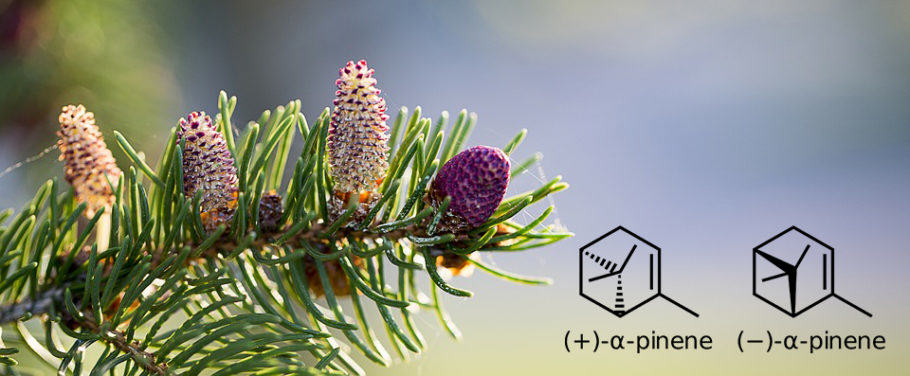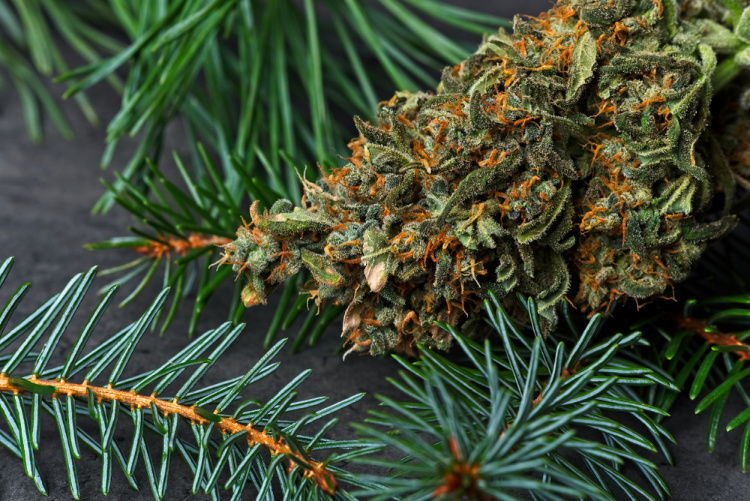Pinene is an aromatic compound commonly found in cannabis that smells a lot like–you guessed it–a forest of pine trees. But pinene may bring more to a strain’s experience than just flavor.
Terpenes like pinene are fragrant oils secreted in cannabis trichomes, and while they originally developed as an adaptive protection against predators, these compounds offer us humans a variety of potential benefits. And, fun fact: pinene can also be found in conifer trees, orange peels, turpentine, pine needles, rosemary, dill, basil, and parsley.
Pinene: What Does It Smell and Taste Like?
Not all terpenes smell like they sound, but pinene is a very special terpene. In addition to—yup, you guessed it—imparting a distinctive aroma of pine or “Christmas tree” to cannabis (and actual pine trees!), pinene is found in a wide range of herbs like rosemary, parsley, basil, and even orange peel.
What is pinene?
As its name would imply, the pinene terpene has the fragrance of a pine tree. Pinene is found in pine trees and other plants, including cannabis. It’s commonly used in insecticides and as a flavoring agent. One unusual potential use of pinene is as a biofuel in spark-ignition engines. That’s because a pinene dimer (two identical pinene molecules linked together) may have volumetric heating values that rank as high as rocket fuel. Researchers at the Georgia Institute of Technology and the Joint Bio-Energy Institute have produced pinene synthetically through the use of a bacterium, according to a 2014 article published in the journal American Chemical Society.
What is the difference between alpha-pinene and beta-pinene?

There are two forms of pinene: alpha-pinene and beta-pinene. Alpha-pinene is more prevalent in cannabis and the most abundant terpenoid found in nature. Researchers are studying whether alpha-pinene can treat or prevent Alzheimer’s disease and other neurological conditions.
What is pinene found in?
The aromatic pine terpene is found in dill, basil, rosemary, parsley, and the essential oils they yield. In addition, coniferous trees, including pine with their fragrant pine needles, are rich in pinene. Besides savoring the refreshing scent of pine trees on a winter day, you may have encountered pinene at your kitchen table. Pine nuts contain pinene oil, as do lime and orange peel. So, if you’ve had orange peel candy, a salad sprinkled with pine nuts, or a slice of key lime pie, you’ve tasted this terpene. In contrast, pinene is known to be highly unattractive to insects, so it’s an ingredient in many repellents.
Pinene: What Does It Do For Us?
If you ever need to convince someone that aromas have an effect on our bodies and our minds, here’s a simple test: Ask them to imagine smelling a freshly cut Christmas tree or an evergreen forest, and then ask what it did for their mood. If it made them feel tingly, uplifted or soothed, that might be all the proof you need. And pinene, as it turns out, has a particularly comforting effect on our airways and bronchial passages.
Pinene: How to Get It from Cannabis
Because a-pinene is so distinctive (and found in many strains), you can often just follow your nose! Otherwise, here are a few strains that typically contain high levels of this powerful terpene:
Blue Dream
This legendary sativa-dominant hybrid is associated with gentle euphoria, creative inspiration, and full-body relaxation. You might note its strong blueberry scent first, but you’ll be hooked by its strong relief of symptoms (without noticeable sedation).
Cannatonic
Typically coming in at a 2:1 CBD/THC ratio, this hybrid strain actually isn’t quite as sedative as the name suggests! Many find it “even-keeled,” offering many medical benefits without the anxiousness and paranoia sometimes associated with too much THC.
Grape Ape
Grape Ape is a musky and potent high-THC indica. With a pronounced grape flavor and a memorable scent, this strain delivers a powerful and long-lasting full-body high.
Harlequin
Harlequin is a popular strain for its strong CBD content. It imparts a sativa-dominant uplift, often coupled with a mild euphoria. It’s gentle enough for daytime activities while imparting a smooth CBD-powered ride.
Pinene’s potential effects and benefits
Just as different cannabinoids have different effects, so do terpenes. These unique attributes contribute to the overall composition of a strain, adding a dimension to each one’s “personality.” Though research is still substantiating pinene’s effects and benefits, the following uses are currently being investigated:
- Anti-inflammatory
- Bronchodilator (helps open airways)
- Anti-anxiety
- Pain relief
- May help combat short-term memory impairment associated with THC
Therapeutic properties of pinene

The predominant type of pinene in cannabis, alpha-pinene, is also the one that could offer the most therapeutic benefits. Potential alpha-pinene benefits are anti-inflammatory, anti-cancer, and antimicrobial, in addition to respiratory and neuroprotective.
Anti-inflammatory
Many plant essential oils that contain pinene have been shown to reduce inflammation. A 2015 study published in the American Journal of Chinese Medicine found that alpha-pinene exhibits a number of anti-inflammatory properties in animal cells. The authors of the study concluded that the terpene has the potential to treat various inflammatory diseases. Interestingly, pinene’s anti-inflammatory effects could make it an effective additive to sunscreen. It prevents skin damage caused by ultraviolet light according to a 2018 study published in the journal Life Sciences.
Anti-cancer
Many studies in animals and other models have concluded that both alpha- and beta-pinene have significant anti-tumor properties. In fact, when consumed together, both forms of pinene appear to have synergistic effects in reducing tumors, as observed in a 2018 study published in the medical journal Chemotherapy. The study also showed that alpha-pinene could be effective in treating prostate cancer in mice.
Antimicrobial
Alpha-pinene and beta-pinene have also been studied for their antimicrobial effects. One 2012 study published in the Swiss scientific journal Molecules demonstrated that pinene was an especially powerful tool in combating Candida Albicans, a yeast fungus found in the human body that can become harmful if it grows out of control.